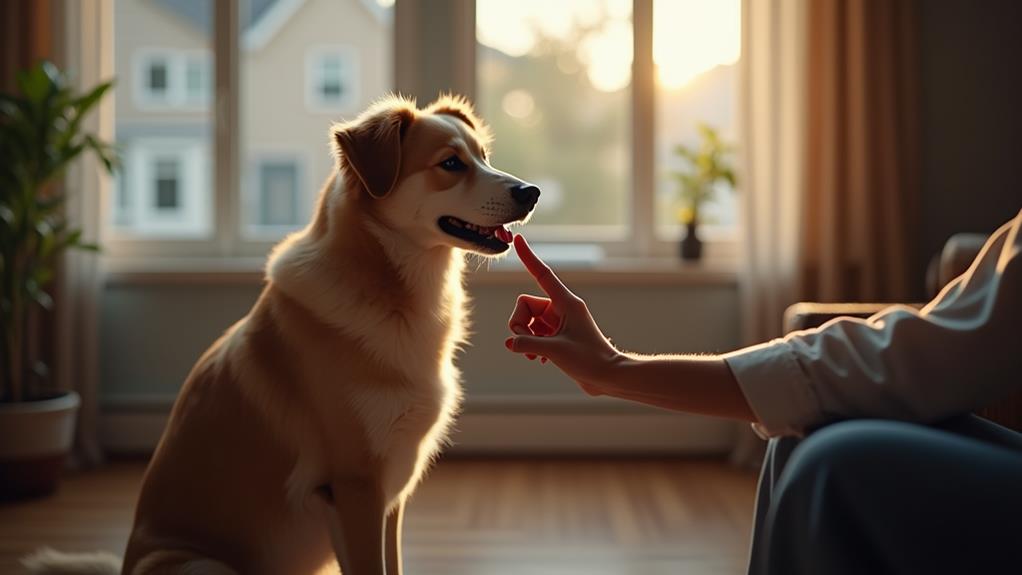To stop excessive dog barking, ensure your dog gets plenty of exercise through regular walks, runs, or playtime. Socialization is critical, so expose your pup to various people and pets to reduce anxiety-related barking.
Provide engaging toys and puzzles to keep their minds occupied when you’re away. Minimize visual triggers and offer a cozy retreat to create a calm environment.
Train your dog to respond to the “quiet” command, consistently rewarding silence. Remember, addressing the root cause of barking, whether boredom, fear, or attention-seeking behavior, is essential. With patience and the right approach, you’ll be on your way to a more peaceful home.
Points To Consider
- Exercise your dog regularly to release energy and reduce boredom-induced barking.
- Socialize your dog with people and pets to minimize anxiety-related barking.
- Provide engaging toys and puzzles to keep your dog mentally stimulated and less prone to bark.
- Create a calm environment by minimizing triggers and providing a comfortable space for your dog.
- Train the “quiet” command and consistently reinforce the desired behavior to manage excessive barking.
Exercise Your Dog Regularly

Release your dog’s energy through regular exercise to curb excessive barking. By providing your canine companion with consistent physical activity, you’ll tire them out, making them more likely to rest peacefully when you’re away. This simple strategy can significantly reduce problem barking and create a calmer home environment.
Incorporate outdoor adventures into your routine to combat boredom, a common trigger for excessive barking. Take your dog on daily walks, runs, or hikes to provide a constructive outlet for their energy.
Consider exploring dog sports like agility or flyball to mentally and physically challenge your pet.
If your schedule is hectic, don’t hesitate to hire a dog walker for mid-day exercise. This guarantees your dog receives necessary activity even when you’re busy.
During colder months, an indoor dog treadmill can be an excellent alternative to maintain your pet’s exercise routine.
Socialize With People and Pets
While exercise addresses your dog’s physical needs, socializing tackles their emotional well-being. Exposing your companion to various people and pets can significantly reduce barking tendencies. Creating positive experiences with diverse individuals, including mail carriers and delivery personnel, will help diminish your dog’s fear and anxiety in new situations.
Start socializing your puppy early to prevent excessive barking habits as it ages. Regularly introduce your dog to different environments and situations to build its confidence in social settings. This approach minimizes fear-based barking and helps your dog become more adaptable.
Consider these socialization strategies:
| Strategy | Benefits |
|---|---|
| Neighborhood walks | Exposure to various sights, sounds, and smells |
| Playdates | Interaction with other dogs in controlled settings |
| Group training classes | Structured socialization with people and pets |
Provide Engaging Toys and Puzzles

How can you keep your dog’s mind occupied and reduce excessive barking? The answer lies in providing engaging toys and puzzles that offer cognitive stimulation.
Interactive toys, especially those that dispense treats, can significantly decrease barking by keeping your canine companion mentally engaged and focused.
Puzzle toys that challenge your dog’s problem-solving skills entertain and stimulate cognitive function, helping to alleviate boredom-related barking.
Regularly rotating various toys will prevent your pet from losing interest and encourage continued play, effectively distracting them from potential barking triggers.
To maximize the benefits of engaging toys and puzzles:
- Choose interactive toys that dispense treats or require problem-solving
- Rotate toys frequently to maintain novelty and interest
- Use puzzles during times when you’re away to minimize anxiety-induced barking
Studies show that dogs with access to mentally stimulating toys exhibit calmer behavior and lower stress levels, reducing excessive barking.
Create a Calming Environment
Your dog’s environment plays an essential role in managing excessive barking. To create a calming atmosphere, start by introducing soothing sounds. Turn on a radio or TV at a low volume to provide familiar background noise to help your beloved companion feel more at ease when left alone.
Next, minimize visual triggers that might provoke barking—close blinds or curtains to reduce outside distractions, creating a more serene space for your dog.
Maintain a tidy and organized area to limit potential sources of anxiety and promote a sense of calm.
Establish a cozy retreat for your pet by providing comfortable bedding and favorite toys. This secure space will help your dog feel safe and relaxed, reducing the likelihood of stress-induced barking.
Train the Quiet Command

Training your dog to respond to the “quiet” command is essential in managing excessive barking. To teach this command effectively, wait for a moment of silence from your dog, then use a calm but firm voice to say “quiet” while immediately rewarding them with treats. Consistency is vital, so practice this command to reinforce the behavior in various situations.
When implementing the “quiet” command, remember these key points:
- Timing rewards: Offer treats immediately after your dog stops barking to create a clear connection between the command and their behavior.
- Avoid reinforcing barking: Don’t respond to your dog when they bark, as this can inadvertently encourage the behavior.
- Distraction training: Gradually increase the level of distraction during training sessions to help your dog remain quiet in stimulating environments.
Pair the “quiet” command with positive reinforcement to strengthen the association between the desired behavior and rewards.
As you progress, practice in different settings to help your dog understand when to be quiet. By consistently applying these techniques, you’ll help your canine companion develop better control over their barking habits, creating a more peaceful environment for both of you.
Frequently Asked Questions
How Do I Stop My Dog From Obsessively Barking?
Identify your dog’s barking triggers and address them through consistent training techniques. Use positive reinforcement to reward quiet behavior. Provide mental stimulation and exercise to reduce boredom-related barking. Stay patient and persistent in your approach.
How Do You Discipline a Dog to Stop Barking?
You shouldn’t “discipline” a dog to stop barking. Instead, use positive reinforcement and behavior modification techniques. Reward quiet behavior, ignore barking, and provide mental stimulation. Consistency and patience are crucial to changing your dog’s vocalization habits.
Why Does My Dog Bark So Much for No Reason?
Your dog’s “no reason” barking likely has triggers you’re missing. Dogs use barking as communication signals. Observe closely to identify what’s prompting the behavior. Once you understand the cause, you can address it effectively.
Can I Squirt My Dog With Water to Stop Barking?
While you can use a water spray for bark training, it’s not recommended. It’s a temporary fix that doesn’t address underlying issues. Instead, focus on positive reinforcement and redirection techniques to effectively manage your dog’s barking behavior in the long term.
The Article: Stop Excessive Dog Barking Was Found On https://happypetsgroomingtable.com/
The Article Stop Excessive Dog Barking First Appeared ON
: https://ad4sc.com




I really appreciate the comprehensive approach you’ve taken to address excessive barking. I’ve found that regular exercise not only helps reduce barking but also strengthens the bond I share with my dog. For instance, taking him on long nature hikes not only tires him out but also gives him new experiences and smells to explore, which seems to satisfy his curiosity.
I found your insights on managing excessive dog barking really resonant, especially since I’ve been navigating this challenge with my own pup, who tends to bark when left alone or when there are unexpected noises outside. It’s interesting how barking can often be a reflection of a dog’s emotional state, whether it’s boredom, anxiety, or a need for attention. I appreciated the emphasis you placed on exercise and socialization; I’ve noticed a significant difference in my dog’s behavior when I increase our daily walks and arrange playdates with other dogs. This not only tires him out physically but seems to contribute to a more relaxed demeanor overall.
I can completely relate to your experience with excessive barking; it can really tie into so many elements of a dog’s overall well-being. It sounds like you’re on the right track with your pup. Increasing walks and socialization not only exhausts their physical energy but also keeps their minds stimulated, which is just as crucial.
It’s interesting how much barking can really reflect a dog’s overall well-being, isn’t it? I’ve noticed that when my dog gets more exercise and socialization, not only does the barking decrease, but he seems more content overall. There’s something about those interactions with other dogs and people that really engages their minds.
You make a really important point about the connection between excessive barking and a dog’s overall well-being. It’s often overlooked how multifaceted this issue can be. Barking can stem from so many different sources—boredom, anxiety, or even the need for attention. It’s intriguing how increasing their physical activity and creating more opportunities for socialization can pull back the curtain on those underlying issues.
It’s great to hear that the article resonated with you! You’re spot on about barking being tied to a dog’s emotional state. It sounds like you’ve got a good grasp on what your pup needs. Exercise and socialization can really change the game. Dogs are social animals, and sometimes just having that chance to romp with others can relieve a lot of stress.
It sounds like you’ve really tapped into the connection between a dog’s emotional state and their barking behaviors. It’s fascinating how much of a difference regular exercise and socialization can make. I’ve noticed something similar with my own dog—there’s a clear correlation between her activity level and her noise level. When she gets that extra energy out during our walks or playdates, she’s noticeably calmer and much less vocal.
I really appreciate the detailed insights you’ve shared on managing excessive dog barking! It’s a challenge many dog owners face, and your approach touches on some critical aspects I’ve experienced firsthand.
It’s great to hear that my insights resonated with your experience. Excessive barking can really test a dog owner’s patience, and it often feels like a balancing act between being supportive of our dogs and managing the peace in our homes. I’ve had my share of challenges with my own dog too, and I found that understanding the underlying causes of barking can really help in tailoring an effective approach.
I found this article really insightful on creating a calm environment for our dogs, and I thought it might resonate with you too, especially with your experience in managing barking.
‘Dog Calming Code: Peaceful Pups Await’
https://www.intrepid21.com/dog-calming-code-peaceful-pups-await/.
I really appreciate your perspective on this. Managing excessive barking can definitely feel like walking a tightrope, and it’s interesting to think about how our dogs interpret their environment. I’ve noticed that sometimes barking stems from anxiety or a need for stimulation, which complicates the situation. It’s fascinating how our pets communicate their needs, even if it can be frustrating at times.
It’s great to hear you’re connecting with what I wrote. Managing barking really can be like balancing on that tightrope, can’t it? Each dog is so unique in how they express themselves, which makes it even trickier. I’ve noticed the same thing you mentioned—barking often isn’t just noise; it’s their way of telling us something’s up.
It’s true—finding that balance can be quite the juggling act. Our dogs communicate so much through their barking, and when we take the time to understand what’s causing it, we can make strides toward a quieter home. I really appreciate your mention of creating a calm environment; that’s something I’ve found crucial as well.
It’s encouraging to hear how you relate to the challenges of managing barking. Finding that balance between supporting our dogs and maintaining peace at home is quite the journey. Each dog is unique, and diving into the reasons behind their barking can unveil a lot. It often leads us to better understand their needs – whether it’s anxiety, boredom, or just alerting us to something in their environment.
I’m glad to hear my thoughts resonated with you regarding managing excessive dog barking. It’s definitely a challenge that can affect both the dogs and their owners. I’ve noticed that sometimes, it’s not just about the barking itself but also about understanding what triggers it.
I found some really useful tips on managing dog barking that echo your insights and might help others navigating the same challenges.
‘Tips for Peaceful Pet Ownership: Stopping Dog Barking’
https://www.intrepid21.com/tips-for-peaceful-pet-ownership-stopping-dog-barking/.
It’s great to hear that my insights resonate with your experience. Excessive barking can be frustrating, and what’s often overlooked is how each dog has a unique trigger. For some, it’s boredom or lack of exercise, while others might bark out of anxiety. Observing your dog closely can reveal surprising patterns.
I really appreciate the depth you went into about managing barking—I think it’s a challenge many dog owners face but isn’t always talked about in detail. I have a rescue pup, and I remember when we first brought him home; he barked at every little noise. It felt like the new “doorbell” was just him announcing every mail delivery, leaf blowing, or even the occasional squirrel that dared to pass by our window.
Your insights on managing excessive dog barking resonate deeply, especially for many dog owners who face this common challenge. I appreciate how you highlighted the multifaceted approach required to address barking effectively. It’s not merely about curbing the noise but understanding the underlying issues that cause it.
I completely agree with you about the importance of understanding the underlying causes of excessive barking. It’s fascinating how each dog can have such unique triggers—some might be reacting to anxiety or boredom, while others are just trying to protect their territory. I’ve seen some owners make real progress by focusing on these individual needs rather than just trying to silence the barking.
I can relate to the challenges of managing pet behavior, which is why I found this guide on booking pet-friendly car rentals particularly helpful for ensuring a smooth journey with our furry friends.
‘Pet-Friendly Car Rentals: Simple Online Booking Made Easy’
https://www.intrepid21.com/pet-friendly-car-rentals-simple-online-booking-made-easy/.
You raise an important point about the individuality of dogs and their triggers for barking. It’s true that factors like anxiety and boredom can play a huge role, and I’ve seen many owners misinterpret these behaviors as mere nuisance barking without digging deeper into what might be causing it. It’s a journey to understand our pets on such a personal level, but when owners take that time, it usually leads to more effective solutions.